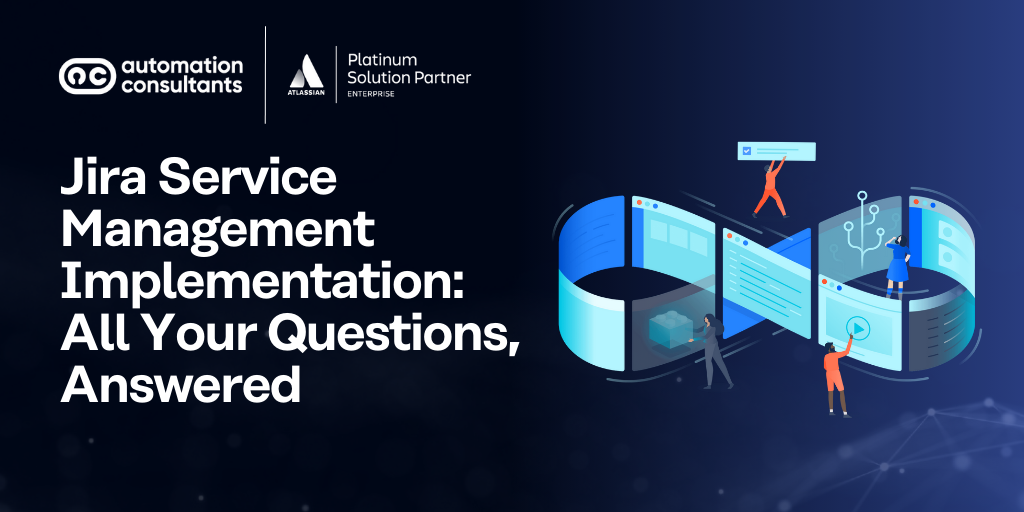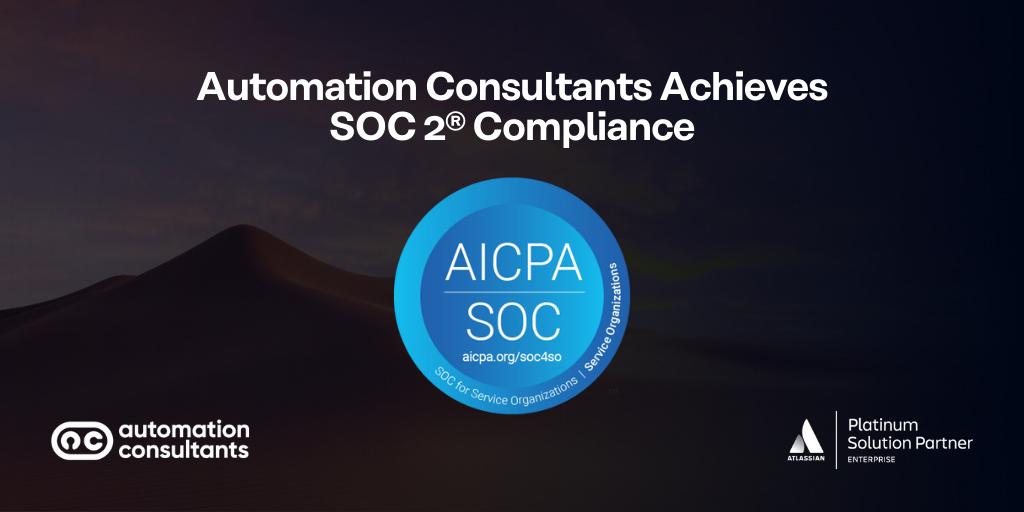As one of the most popular ITSM tools out there, Jira Service Management (JSM) is used by organisations across the globe to handle service desk delivery, incident resolution, knowledge management, assets and more.
If you’re getting ready to move to a new ITSM platform, like JSM, you may be wondering about the implementation phase. How long will it take? What will the impact be on your BAU activities? And what about integrations or custom config?
We’re here to guide you through some of the most common questions around Jira Service Management implementation. We’ll cover:
- Jira Service Management key features and benefits
- How does a JSM implementation support ITIL practices?
- Migrating to JSM Cloud: What should you expect
- How to implement Jira Service Management
- How do you prepare for a JSM implementation?
- Jira Service Management integration setup
- How to set up SLAs in Jira Service Management
- How to test JSM: Tips for UAT
- What to expect from Atlassian customer service and support
- What’s the difference between Jira Service Management and Jira?
Let’s get started.
Jira Service Management key features
Jira Service Management is Atlassian’s ITSM platform, designed to handle core processes from request management through to asset management. It began life as Jira Service Desk, before relaunching in 2022 as the JSM we know today.
Now, in Gartner’s latest Market Guide for IT Service Management platforms (in which JSM is one of only eight selected vendors), it lists the following ‘must-have capabilities’ for ITSM tools:
Incident management: Benefitting from a native integration with Jira, you can connect IT, Ops and Development in one seamless feedback loop, for faster and smoother incident escalation and resolution.
Problem management: JSM comes with a pre-built problem management workflow, which supports core ITIL-recommendations around identifying, prioritising and resolving problems. Again, the JSM-Jira integration is invaluable here, looping in Development teams quickly and easily. This existing workflow can be configured to reflect your organisation’s unique needs and processes.
Request management: JSM provides comprehensive Service Desk functionality for each team within your organisation, from HR to IT. With a branded portal (for more comprehensive design and branding options, it’s worth exploring apps on the Atlassian Marketplace), employees or customers can raise requests. JSM supports self-service with suggested knowledge base articles and can resolve requests without human agents with AI-powered JSM Virtual Agents (freeing up your human teammates to focus on more strategic or complex tickets).
Change management: With a native change management workflow, you can quickly establish and automate processes for change requests, review and approval, and implementation. Again, you can configure this workflow to suit your team’s requirements.
Knowledge management: Powered by Confluence, JSM’s knowledge base provides a clean and intuitive experience both for knowledge article creators, and for those reading the content. Analytics enable you to identify the most popular articles, and to understand which have aided ticket resolution.
Jira Service Management benefits:
Ultimately, JSM provides a centralised, secure and collaborative IT Service Management offering, connecting teams across your organisation to investigate and resolve requests, problems and incidents more quickly.
With increasingly sophisticated AI-powered tools, from JSM Virtual Agents to Atlassian Rovo’s enterprise search, JSM connects your teammates, enhances customer satisfaction and reduces inefficiencies and the administrative burden of core ITSM processes.
Want to see the full comparison of all ITSM tools? In this guide, we break down how four of the leading ITSM solutions – ServiceNow, BMC Helix, Zendesk, Ivanti, and Jira Service Management – compare across multiple essential criteria like request management, incident management, knowledge management, reporting and analytics, integrations,
How does a JSM implementation support ITIL practices?
By implementing JSM, your organisation is well on its way to embedding strong ITSM processes that align with ITIL’s recommended practices.
Now, ITIL 4, the most recent version of the popular ITSM framework, incorporates 34 managed practices – so we won’t go into all of them here. We will, however, highlight a few core ones that can be supported by JSM.
Change enablement
Incident management
Service desk
Service request management
Software development and management: Whilst Jira Service Management itself is not a Developer tool, its native integration with Jira supports this principle.
Migrating to Jira Service Management Cloud: What to expect?
Whether you’re migrating to Atlassian Cloud from Data Center, or you’re moving from an different platform entirely to JSM, most migrations follow a fairly typical structure (as recommended by Atlassian):
Assess: Use this phase to review your existing techstack, migration tooling, stakeholders and resource. In doing this, you can start to anticipate how complex your migration may be (often we see a correlation between a high volume of users/data/custom configuration and the resulting complexity of migrating this data), and which approach you’ll subsequently take to manage it.
Plan: Taking the insights from your assessment stage, you’re now going to assemble a plan, covering everything from key migration roles across your organisation, to establishing clear communication channels.
Preparation: Leaving plenty of time, in this phase you should begin communicating with key stakeholders, putting together a robust checklist and start considering post-migration activities, such as training or support for users.
Test: Running a test migration is, in our experience, vital. From providing a clearer idea of timescales, to uncovering unforeseen issues, you should always do a test run. It helps identify where there could be cracks in your plan so you can be truly ready for the real migration.
Migrate: Ideally, by this point, impacted stakeholders will have had lots of notice of the impending JSM Cloud migration, and that BAU activities, resourcing and deadlines have been managed effectively. In terms of migration method, Atlassian generally recommends the ‘Lift and Shift’ approach.
Launch: Migration done, job done? Of course not! Now comes the part of supporting your team, engaging JSM champions and promoting best practice and training.
🌎 Read more!
We recently wrote extensively on preparing for a Cloud (AWS) migration, with practical steps to success. If you’re preparing for a Cloud migration, or even just considering making the move from on-premises to Cloud, we’ve got just the thing for you in this article.
How to implement Jira Service Management
At a basic level, Jira Service Management is designed to be quick and easy to set up. Projects lie at the heart of JSM, and the platform comes with a range of templates to get teams started, such as IT or Customer Service Management.
However, unless you’re a very small team (in which case you may be able to use JSM for free, and set it up yourself), or have incredibly straightforward processes, it’s likely you’ll want to customise your processes, request types, workflows and automations – and to truly reflect your requirements, we anticipate your instance may need unique reconfiguration.
How do you prepare for a JSM implementation?
We touched on ways to prepare in our section on JSM Cloud migration, but it’s worth highlighting a few points here again..
In our experience, we’ve found that ahead of any significant change, like implementing a new tool, communication is one of the most important – but often undervalued – elements.
Provide notice (lots of notice): Make sure people know that change is coming, and build in time for them to question, possibly resist, and understand how that change will impact them.
Explain why: We’re all creatures of habit and we tend not to like change. So, explain why embedding this new tooling, like JSM, is going to improve your teams’ work. What benefits will they experience?
Allow enough time for UAT: User Acceptance Test is a critical period following a migration and/or implementation. Build in enough time for users to actively test a new application (in this case, Jira Service Management) and report any teething issues they encounter.
Invest in training and support: Certified Atlassian training courses can be a good place to start, to upskill your team and encourage confident adoption. It’s also a good idea to appoint JSM Champions, who can promote the benefits of the tool, and perhaps provide peer-to-peer support.
Looking for a deeper understanding of ITIL? We’ve a detailed ITIL guide that explains its processes and practices. Read it here.
Jira Service Management integration setup
Integrations play an invaluable role in enhancing your ITSM solution, widening its scope, enhancing collaboration and data-sharing between teams, and cementing its place at the heart of your IT Service delivery.
From native integration with Jira (which we’ve touched on several times already in this piece), to integrating with third-party apps, like those found on the Atlassian Marketplace, Jira Service Management can support myriad integrations. These include:
Integration with other products in the Atlassian System of Work, including Jira, Confluence and Rovo
Additional Atlassian tools like Atlassian Guard (to enable SSO, or sync with IAM solutions, for example), Opsgenie (for alert processes), or JSM Assets (to create a CMDB solution).
Dedicated JSM plugins from the Atlassian Marketplace, such as Refined, an app which enables greater customisation and design choices for your portal
Integration with comms platforms, such as Microsoft Teams or Slack
Email integration, like Outlook or Gmail
And many more…
Do note that bidirectional integrations are only available on JSM Premium or Enterprise plans.
How do you set up SLAs in Jira Service Management?
A Service Level Agreement (SLA) is a commitment that you (as the service provider) make, and to which the customer agrees, often around the quality, speed and availability of service. For example, your SLAs may focus on system uptime, or response or resolution speed.
SLAs often form the crux of customer expectations and define what constitutes acceptable service. What’s perhaps more important than the SLAs themselves, is how you track and measure them.
Jira Service Management provides pre-built SLAs, which you can simply select from within project settings. You can also create custom SLAs. JSM also enables you to set up Service Level Agreement goals, to ensure your team are all aware of what they’re working towards, and whether they’re meeting expectations.
JSM also enables you to create SLA calendars, goal grouping by priority, SLA conditions and more – all designed to provide stronger and more holistic SLA management and monitoring.
How to test JSM: Tips for UAT
UAT involves thorough testing of the solution to ensure it meets all your needs and expectations and is a vital part of any implementation project.
Leave enough time: Ensure you allow sufficient time to focus on UAT – it can be a lengthy process but is worth it, as it can identify areas where configuration needs to be tweaked to suit your needs.
Encourage users to be hands on: Try to get your team to use JSM it as you would after launch, to really get a feel for the tool.
Log errors or teething issues: Carefully record any errors that you find, ideally in a centralised location (hello Confluence), or anything that doesn’t work the way you’d expect it to.
Read all about the ITSM best practices that will help you achieve more efficient processes.
What should you expect from Atlassian support?
One of the things we rate highly about Atlassian is the active community forums, where users can share challenges, trouble-shoot for one another and exchange best practice. Often, the answer to a solution can be found within a community discussion.
For JSM Cloud users, Atlassian can provide first and second-line support, for general troubleshooting and resolving fairly straightforward problems.
For more complex queries or long-term support however, particularly after a significant transition like a Cloud migration or Jira Service Management implementation, it may be worth exploring a dedicated Atlassian Managed Services provider.
Specialising in third-line support, which can encompass everything from process optimisation to managing JSM integrations, here at AC we can be a safe pair of hands for your Atlassian support. Think of us as an extension of your team, perhaps fulfilling the role of a Jira Admin, or helping you navigate the intricacies of custom configuration.
You can find out more about our Atlassian Managed Services provision here.
What’s the difference between Jira Service Management and Jira?
Our last question doesn’t necessarily relate to Jira Service Management implementation directly, but it is a common one. In a nutshell, Jira Service Management is an ITSM platform, providing service desk, incident management and knowledge management services amongst others. Jira, meanwhile, is an Agile project management tool, primarily used by software development teams. Prior to 2024, Jira used to be known as Jira Software.
When Jira Service Management and Jira are both in place at an organisation, they’re often closely integrated. This enables your IT service desk team, for example, to instantly escalate requests or issues, looping in your Software Development team, seamlessly sharing and syncing real-time ticket updates, and collaborating together for a quick resolution.
JSM implementation: Have we answered all your questions?
It’s possible we haven’t – after all, your Jira Service Management implementation may look different to next organisation’s, and it’s all dependent on your unique requirements, processes and user base. However, we hope we’ve tackled a few common queries – and if you still have questions, why not talk to us?
We offer a free consultation, an informal and flexible 30-minute session where you can talk to us about your teams’ needs, share your challenges and learn how we could support you. Whether you’re embarking on a Atlassian Cloud migration, or need support with JSM reconfiguration, we can guide you to long-term success.





